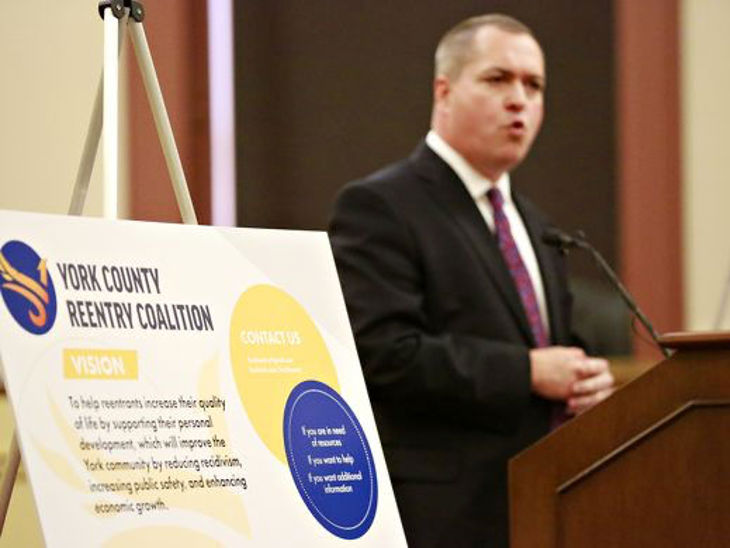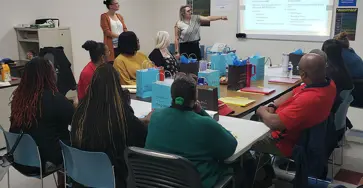
After making the turn onto Academy Drive off Route 10, you quickly realize you are on one of those never-ending roads and wonder if you are ever going to get to your destination. The entrance to Abraxas Academy, tucked away in the borough of New Morgan, is a welcome relief.
Within the walls of the facility, which has an approximately 20-foot-high fence around the grounds, you might be surprised to come across farm animals, a chicken coop, produce growing in a greenhouse, a butterfly garden and a beehive - until you learn that they are all part of therapy programming.
Abraxas Academy uses the Sanctuary Model for Trauma Informed Care as the basis of its treatment for residents ages 14 to 18. In addition, the academy is a licensed private academic school where residents can earn high school diplomas.
"They are court-appointed as part of being in the juvenile (court) system," said Dan Stringfellow, the director of facilities at the academy.
Currently there are 80 to 90 residents at the facility, and the length of stay varies.
"For our secure treatment program, which is our sex offenders program, and our habitual offenders program, the average length of stay is 10 to 12 months," he said. "We have a shelter and detention program that is about 17 days in each of those programs."
The goal of the facility is to offer the residents treatment to return to society.
"A lot of our kids have experienced trauma in their lives and they have gone wayward in their young lives, and the courts turn to us to offer them treatment so they can learn how to be successful in society and back in their communities," said Carla Spatz, the education director at the academy.
Creative programming
Part of how they do that is to offer creative programming, such as one program centered on horticulture, another on animals, one in the culinary arts and yet another in carpentry. About five years ago, the academy built a greenhouse and soon hired a horticulture instructor.
"Over the years the program has grown," Stringfellow said. "Right now we grow all types of plants in our greenhouse year-round."
On a typical day, a few of the teen residents are helping out James Brunner, the horticulture teacher, who has a background in environmental biology.
"It's very hands-on," said Brunner, who has been working at the academy for four years. "They have a lot of freedom with what they want to grow out here."
One day during the winter months, they were working on making a trellis for peas they were growing, among other projects that were in progress.
"We made an herb palette garden that mounts on a wall," Brunner said.
They also installed a hydroponic growing system.
"We had it set up so that you can probably grow 30 or 40 heads of lettuce," Stringfellow said. "In the wintertime we grow lettuce strictly by adding minerals to the water."
In the summertime, the field located behind the facility that is enclosed by security fencing serves as both an area for small-scale farming and a recreational area for residents.
"We have a plow and a disc, and the kids work the land and they raise sweet corn, watermelon, tomatoes, onions, peppers and asparagus," Stringfellow said.
Farm-to-table cafeteria
Brunner said you can name any vegetable and most likely they have grown it. The food is served in the academy's farm-to-table cafeteria, and in the future, Brunner is hoping to provide a local food bank with the excess. During harvest season, the response to eating the food grown by residents has been positive.
"They eat onions like apples, and sweet corn is gone in a week," said Brunner.
The horticulture program is voluntary and one of five technical education programs offered to residents, and among the three programs in which residents can work to earn money.
"We sell the vegetables to the staff, and that money goes into a fund, and the kids can earn up to $600 during their stay to help them pay for any court costs and fines they may have coming in here," Stringfellow said.
While their horticulture program has been developing for years, a more recently introduced program is based on animal therapy. The program is made up of animals that are rescues found through websites such as Craigslist and various animal-related sites.
"We have a huge selection inside and out," Stringfellow said. "Outside, we have a goat, chickens and a potbellied pig, and inside, we have ferrets, guinea pigs, rabbits, all sorts of reptiles, doves, parakeets."
The time the residents get to spend with the animals is overseen by the science teacher, who dedicates 45-minute periods to them two to three days a week.
"He did a short curriculum about the animals where they learned about them and how you take care of them," said Jessica Bailey, who oversees the animals. "We run over the rules of how you handle animals and we made a contract that the kids had to sign."
Animals teach empathy
Stringfellow and Spatz conveyed that the program has been a hit with the residents ever since it was established about 10 months ago.
"The kids relate really well with the animals," Spatz said.
However, reactions by the youth who come into contact with the animals can be mixed initially, but it typically doesn't last long.
"Some of the kids were terrified," said Bailey. "Slowly but surely they warm up to them."
Bailey said she enjoys seeing which animals the residents gravitate toward and noted that Fred the potbellied pig gets visibly excited when the kids play with him. She also gets to see, firsthand, the impact the animals have on the residents.
"The ones who think they are big and hardcore and have no emotion show it in here," Bailey said.
Their animal therapy program does more than offer children a chance to help care for the animals through feeding them and cleaning their cages.
"Our animal program teaches the kids empathy, to learn how to take care of something, and it gives them responsibility," Spatz said. "A lot of these kids don't have responsibility, and it gives them work ethic."
The work ethic component is something they can take out into the real world.
"One of the things we are still working on with our animal assisted program is, there is a certification through a major pet retailer, so the kids who will leave in animal therapy will be able to go to one of those retailers as an entry level employee," Stringfellow said.
The outdoor animals also need daily care. Residents collect and wash the eggs and clean out the chicken coop.
Every time an animal is added, they run a contest to name it. Their resident ferrets were named Jenny and Forrest.
Bonding with animals
When residents are discharged from the academy, they get time with the animals to make the transition easier.
"When they call back to the facility they ask how Jenny and Forrest are doing," Spatz said. "The kids have really bonded with these animals, and they leave here and they are losing something."
A 15-year-old resident, who could not be identified due to confidentiality agreements, enjoys the time he spends with the animals.
"I like to help the animals a lot," he said. "Every Wednesday we clean and play with the animals, and it gives me a break from school."
During the 45-minute period he gets to spend with them, he has learned many aspects of caring for them.
"It helps me learn how to clean and help animals out and how to take care of animals," he said.
When he is discharged from the academy and returns home, he has a plan to get a dog.
"When I go home, I'm going to ask my mom," he said.
In some cases, residents who have been discharged will call back to share that they now have a pet of their own at home for the first time.
"It is probably one of the most meaningful programs in the building when the kids get to work with the animals," Spatz said.
Stringfellow also shared the impact he has seen both programs have on their residents.
"We have seen some real success with our kids," he said. "Developing the programs has meant a lot to me."

